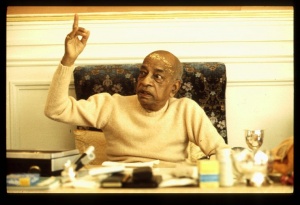CC Madhya 20.307 (1975)

A.C. Bhaktivedanta Swami Prabhupada
TEXT 307
- nijāṁśa-kalāya kṛṣṇa tamo-guṇa aṅgīkari'
- saṁhārārthe māyā-saṅge rudra-rūpa dhari
SYNONYMS
nija-aṁśa—of His personal plenary expansion; kalāya—by an expansion known as kalā; kṛṣṇa—Lord Kṛṣṇa; tamaḥ-guṇa—the material mode of darkness; aṅgīkari'-accepting; saṁhāra-arthe—for the purpose of dissolution; māyā-saṅge—in association with the external energy; rudra-rūpa—the form of Rudra; dhari—assumes.
TRANSLATION
"Lord Kṛṣṇa, the Supreme Personality of Godhead, expands a portion of His plenary portion and, accepting the association of the material mode of ignorance, assumes the form of Rudra to dissolve the cosmic manifestation.
PURPORT
This is a description of the Rudra form, which is another expansion of Kṛṣṇa. Only viṣṇu-mūrtis are expansions of Kṛṣṇa's personal and plenary portions. Mahā Viṣṇu, who lies on the Causal Ocean, is an expansion of Saṅkarṣaṇa. When Garbhodakaśāyī Viṣṇu accepts the material modes of nature for the purpose of dissolving the cosmic manifestation, His form is called Rudra. As already explained, Lord Viṣṇu is the controller of māyā. How, then, can He associate with māyā? The conclusion is that the incarnation of Lord Śiva or Lord Brahmā indicates the absence of the supreme power of Viṣṇu. When the supreme power is not there, it is possible to associate with māyā, the external energy. Lord Brahmā and Lord Śiva are to be considered creations of māyā.